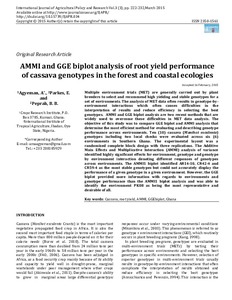| dc.contributor.author | Agyeman, A. |
| dc.contributor.author | Parkes, E. |
| dc.contributor.author | Peprah, B.B. |
| dc.date.accessioned | 2019-12-04T10:57:22Z |
| dc.date.available | 2019-12-04T10:57:22Z |
| dc.date.issued | 2015-03-15 |
| dc.identifier.citation | Agyeman, A., Parkes, E., & Peprah, B. B. (2015). AMMI and GGE biplot analyses of root yield performance of cassava genotypes in forest and coastal ecologies. International Journal of Agricultural Policy and Research, 3(3), 122-132. |
| dc.identifier.issn | 2350 - 1561 |
| dc.identifier.uri | https://hdl.handle.net/20.500.12478/713 |
| dc.description.abstract | M
ultiple environment trials (MET)
are generally carried out by plant
breeders
to select and recommend high yielding and stable genotypes for
a
set of environments. The analysis of MET data often results in genotype
-
by
-
environment interactions
which
often causes difficulties in the
interpretation of results and reduce efficiency in selecting the
best
genotypes
. AMMI and GGE biplot analysis are two recent methods that are
widely used
to overcome these difficulties in
MET data analysis. The
objec
tive of this
study
was
to
compare GGE biplot and AMMI analysis t
hat
determine the most efficient method for evaluating and describing genotype
performance across environments
.
T
en (10) cassava (
Manihot esculenta
)
genotypes including two
local
checks were e
valuated across six (6)
environments in Southern Ghana
.
The experimental layout was a
randomized complete block design with three replications. The Additive
M
ain
E
ffects and
M
ultiplicative
I
nteraction (AMMI) analysis of variance
identified highly significa
nt effects for environment, genotype and genotype
by environment interaction denoting different responses of genotypes
across environments. The AMMI1 biplot identified
AR14
-
10
, CR42
-
4 and
CR59
-
4
as the most stable genotypes but could not accurately display
the
performance of a given genotype in a given environment. However, the GGE
biplot provided
more information with regards to environments and
genotype performance than the AMMI1 biplot analysis
and was able to
identify
the
environment PK08
as being
the m
ost
representative and
desirable of all |
| dc.format.extent | 222 - 232 |
| dc.language.iso | en |
| dc.subject | Cassava |
| dc.title | AMMI and GGE biplot analysis of root yield performance of cassava genotypes in the forest and coastal ecologies |
| dc.type | Journal Article |
| dc.description.version | Peer Review |
| cg.contributor.affiliation | International Institute of Tropical Agriculture |
| cg.contributor.affiliation | Council for Scientific and Industrial Research, Ghana |
| cg.coverage.region | Africa South Of Sahara |
| cg.coverage.country | Nigeria |
| cg.researchtheme | BIOTECH & PLANT BREEDING |
| cg.authorship.types | CGIAR and developing country institute |
| cg.iitasubject | Cassava |
| cg.iitasubject | Plant Breeding |
| cg.journal | International Journal of Agricultural Policy and Research |
| cg.accessibilitystatus | Limited Access |
| local.dspaceid | 70330 |
| cg.identifier.doi | https://dx.doi.org/10.15739/IJAPR.034 |

